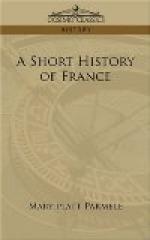The first truly great Capetian king came with this emergency. Philip Augustus, son of Louis VII., in the year 1180, when only fifteen years of age, seized the reins with the hand of a born ruler. Before he was twenty-one he had broken up a combination of feudal barons against him. Then he turned to England. Queen Eleanor and her sons were conspiring against Henry II. So he made friends with them. The palace on the island in the Seine was an asylum where John and Richard might plot against their father. And when a third Crusade was planned, 1189, it had as leaders Philip Augustus of France, Richard I., who had just succeeded his father, Henry II., as King of England, and Barbarossa (Frederick I.), the great Emperor of Germany. Before the Holy Land was reached the wise and crafty Philip Augustus and the fiery Richard had quarrelled.
Philip had been carefully observing these two brothers who were successively to wear the crown of England. He knew the foibles of the romantic and picturesque Richard; and he also knew that John, corrupt to the core, was a traitor to whom no trust would be sacred. In his own cold-blooded fashion he intended to use them both.
John had conspired against his own father, now Philip would help him to supplant his brother, while Richard was safely occupied in Palestine. And when he had made John king, he, Philip Augustus, was to be rewarded by the gift of Normandy! With this in view, Philip returned to France. It was an ingenious plot, but all was spoiled by Richard’s safe return from the thrilling adventures of the Crusade. In 1199, however, the crown passed naturally to John by the death of his brother, and this vicious son of Eleanor was King of England.
There were other means of recovering his lost possessions. Philip espoused the cause of the young Arthur, John’s nephew, a rival claimant to the English throne. And when that ill-fated Prince was murdered, as is believed by the orders of his uncle, for this and other offences King John, as Duke of Normandy—thence vassal to the King of France—was summoned to be tried by his peers.
When after oft-repeated summons John refused to appear at Philip’s court, by feudal law the King of France had legal authority to take possession of the dukedom.
In vain did King John strive to defend by arms his vanishing possessions. In the war which ensued, all north of the Loire was seized by Philip, and at one stroke he had mastered his enemies at home and abroad.
Not only were Normandy, Anjou, Touraine, and Poitou restored to France, but they were hereafter to be held, not by dukes and counts, as before, but by the king, as a part of the royal domain. And kingship, towering high above all the great barons of France, had for the first time become a reality.
It was Philip’s policy of expansion which gave color to his reign; not an expansion which would bring extension into foreign lands, but solidity and firmness of outline to France itself. We have seen how and why this policy was vigorously carried out in the north. The growth toward the south is a less pleasant story.




